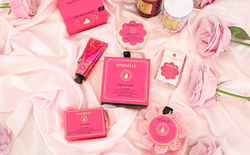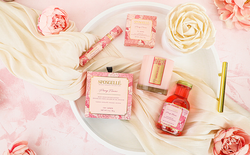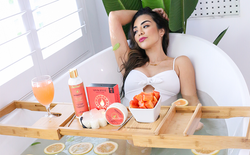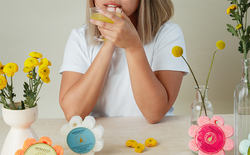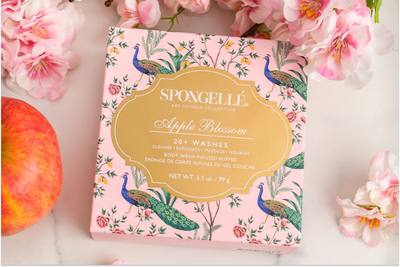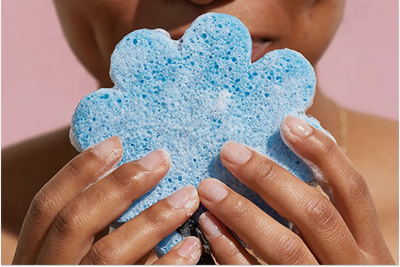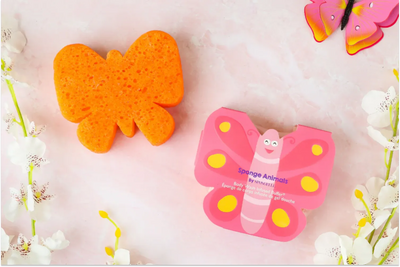If there is one thing I am certain of in the world today, it is that self-care and skincare are no longer a luxury. They are an essential part of staying healthy and staying sane. With the increase of hand sanitation and harsh germ-fighting chemicals everywhere, not to mention masks, it’s a real thing.
Implementing a skincare routine that not only protects us from these harsh cleansers, but also helps us relax, reduces stress, and invests in our bodies is essential.
However, a skincare routine could mean a million different things depending on who you ask:
- Is it putting on the occasional sheet mask to fight acne?
- Is it an extensive list of serums you apply each and every night?
- Is it subscription services that send you the next beauty trend?
- Or is it the person who goes through tubs of over the counter creams to help calm the inflammation of their psoriasis or eczema?
- Is it slathering on hand sanitizer before and after grocery shopping?
The reality, of course, is that all of the above is true. A skincare routine is designed around the skin it is caring for.
Because of the thousands of products on the market plus YouTube videos and blog writers that swear by their routines, it can be pretty overwhelming for the skincare novice just starting on their skincare journey.
The biggest thing to remember is that skin care is self-care, and caring for your body should be at the top of your list.
So, here’s the beginner’s guide to taking better care of your body!
Step One: Learn your skin type.
There are three main skin types, and then there are combination and sensitive skin types. You can have sensitive skin and oily skin at the same time. Let’s spend some time in front of a mirror, assessing the different problem zones of the face.
- Notice your T-zone, the area across your forehead that crosses like the letter T and runs between your brows. Is it dry and flaky? Is it oily and prone to bumps and blemishes?
- Look at the soft skin along the inside of your cheeks at either side of your nose. Is it red and blotchy, or is it oily and covered in small bumps and blemishes?
- Is your chin prone to breakouts? Is it pink and rough?
- Now let’s look at your arms and elbows. Do you have tender, cracked skin or tiny bumps with ingrown hairs there?
Now that you’ve had a chance to look over some of the different aspects of your skin, let’s translate what we saw into our skin type:
- Dry, a rough, and flaky t-zone, rosacea and reddened cheeks, dry, cracked lips, and sensitive, cracked elbows are all signs of dry skin.
- Oily, a blemished t-zone, nose, and cheeks are a telltale sign of oily skin.
- Normal, very little dryness, very few blemishes.
- Combination, a slight dryness here or there, and some oily patches too.
Knowing your skin type and identifying your problem areas means you will know how to approach and treat each area of your skin!
Step Two: Implement a basic morning and night routine.
When you are first starting out, all you need to do is start. Try out this three-step morning and four-step nighttime routine to ease you into skincare and get you comfortable with a habit.
Morning Routine
- Cleanse
- Moisturize
- Apply SPF
Keeping your morning routine simple means you can head into your day with a fresh, clean face and not have to worry about heavy products or routines. Just make sure you always, always apply sunscreen before you leave the house.
If you participate in exercise throughout the day, take your routine with you and start over after your workout. This will keep sweat and build up out of your pores and ensure your skin is still protected from harsh UV rays with a fresh layer of SPF since you probably sweated off the last.
Night Routine
- Cleanse
- Exfoliate (once a week)
- Treat
- Moisturize
A nighttime routine should be a little longer to account for all the rich and moisturizing serums and treatments you will want to add to your routine so you can wake up with glowing hydrating skin.
Nighttime is also a great time to implement a weekly exfoliation routine of your face and your body to help deep clean your pores and remove any dead cell build-up that could clog pores or cause ingrown hairs. If you want to keep it simple, use a body wash infused buffer to exfoliate and cleanse in one go.
Just be sure you moisturize directly after your exfoliation treatment, preferably when your skin is still damp as damp skin will better absorb the moisturizer.
Step Three: Address specific skin care needs.
You may have naturally dry skin or naturally oily skin. Both of these skin types can lead to their own set of problems. It’s essential to care for these problem areas as soon as you notice them to avoid more significant problems later.
If your skin suffers from redness and extreme dryness, remove drying cleansers and products with alcohol from your routine.
Go ahead and throw those bad guys away. If you have dry skin, there is no need for you to ever apply harsh products and cleanser on your skin. Opt for a gentle cleanser instead that moisturizes while it cleanses.
Moisturize on every level.
The key to protecting and alleviating dry skin is moisture. Ensure your cleansers are moisturizing, make sure your makeup is moisturizing, and make sure you are adding moisture back into your skin every morning and night.
If your skin is often oily and breaks out easy, switch to an oil-based cleanser.
We know, we know. We hear this every time we suggest this, but an oil cleanser really is your best tool when it comes to fighting acne and clogged pores.
Oil cleansers penetrate deep, removing build-up that may have gotten mixed up with our skin’s natural oils. Oil cleansers protect and cleanse this barrier without stripping it.
And, over time, your skin will adjust to oil-based cleansers and oil production in your skin could balance out over a longer period of use.
Try a gentle clay mask over drying, harsh spot treatments.
In the grand scheme of things, most products marketed towards acne-prone skin are drying and unnecessary. Want to treat your blemishes?
Try a natural clay mask to help lift impurities and remove excess oil from the skin. Just be sure to cleanse your skin after using the mask to be sure to remove any leftover residue.
Try implementing a toner before you moisturize.
Toners are the last step in cleansing and the first step in moisturizing. They help remove any remaining residue or build-up on the skin while cleansing the individual pores.
You can use a cotton pad to apply a toner.
Up your moisturizer game.
While hormones are a contributing factor to oily skin, excess sebum production can be slowed when the skin is adequately moisturized.
If your skin has very few areas of dryness or blemishes, then your skin is most likely normal, and you can stick to a regular cleansing, moisturizing, and SPF routine.
Make sure your skin stays clean and clear and hydrated by sticking to a simple routine. You can always add in a gentle exfoliation routine or a serum or two to increase hydration and your overall skin glow.
Step Four: Learn about active ingredients and how they affect your skin.
Start reading labels. Active ingredients on the label are the ingredients that are actually treating your skin issue. Learning the different active ingredients will save you discomfort and irritation down the road from treating your skin incorrectly.
Allure has put together an incredibly comprehensive skincare glossary that defines almost every term and ingredient out there.
Step Five: Be patient and committed to the routine.
We all want to see beautiful glowing skin overnight, but that just isn’t the case. Sure, some results you’ll see quickly, but most take time. Your skin needs time to get used to its new environment and treatments. The best skincare routine is one that is kept.
Change your mindset and see your routine as something that is healthful and beneficial for the rest of your life, like brushing your teeth, and not just something to treat your skin for a specific problem.
Skincare is just that: caring for your skin. Like it or not, we are stuck with the skin we are in for the rest of our lives, and just like our teeth and our fingernails, we need our skin to stay healthy so we can stay healthy.
Start upping your skincare routine today with one of our body wash infused buffers. And, as an added bonus, use code BLOG20 for 20% off your first order!Sources:
https://www.self.com/story/guide-to-skin-care
https://www.shape.com/lifestyle/beauty-style/maskne-face-mask-acne-mechanica
https://www.allure.com/story/skin-care-terms-glossary-definitions


